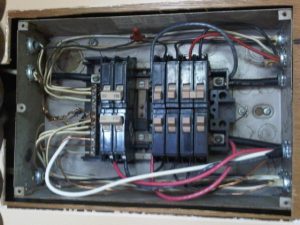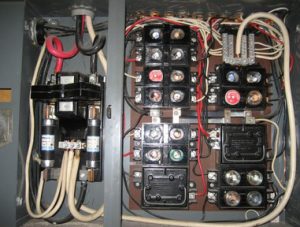Four Unsafe Electrical Panels Hiding in Your Home
If you own an older home (built prior to 1990), you may have one of these outdated main electric panels (boxes) in your home. Electrical panels contain safety devices (either fuses or circuit breakers) that trip and shut off the power when too much electricity flows through them, helping to prevent fires caused by overheating wires.
There are many homes in the Augusta, GA area that still contain old, outdated electrical panels that might not work as intended, leaving homeowners vulnerable to a house fire.
If you have one of the below panels, you should consider having them replaced as soon as possible!
IF YOU HAVE ONE OF THE BELOW… TAKE ACTION TODAY!
If you have one of these unsafe and outdated electrical panels, we highly recommend replacing them. At the very least, you should have an electrician inspect the panel to see if there are any signs of problems. Give us a call today and we will set an appointment to come inspect your home’s panels.





Federal Pacific Electric (FPE) Panels
From the 1950s to the 1980s, Federal Pacific Electric was one of the most popular manufacturers of electrical panels in the United States, with products installed in millions of homes. These panels are considered extremely unsafe because FPE electrical panels contain circuit breakers that fail to trip when they should (when there’s a short circuit or circuit overload). This problem has led to thousands of fires across the United States. There are also reports that FPE circuits in the off position will still send power to the circuit, which can cause electrocution when working on a circuit, even when you believe to be off.
How to tell if you have an FPE Panel:
These panels are most common in homes built between 1950 and 1980. Federal Pacific Electric may appear on the cover of the breaker box. Also, look for the name Stab-Loc inside (the brand name of the circuit breakers).
Zinsco Panels
Zinsco or GTE-Sylvania brands had electrical panels installed in homes throughout the 1970s. Zinsco is now defunct, but homes built during this era may still have these panels in place.
The circuit breakers inside many Zinsco panels may melt to the main “bus bar,” creating a hazard for the homeowner. This means the breaker’s trip function will be disabled. Without a trip function in place, a surge of power can melt wires and start fires in your home.
How to tell if you have a Zinsco Panel:
Check your panel box for the Zinsco brand name. Also, many GTE-Sylvania or Sylvania panels are simply re-branded Zinsco panels or contain the problem Zinsco design. These should also be replaced.
Note: Only some Sylvania and GTE-Sylvania branded panels are dangerous. An electrician will need to inspect it to see if it has the design flaw.
Split-bus Electrical Panels
A typical, modern circuit breaker has a single metal bus. Electricity comes into the panel, passes through a main breaker and to the bus. The bus then connects to each individual circuit breaker, providing power to your entire home.
You can then shut off power to the bus (and therefore your entire home) simply by turning off the main breaker.
Split-bus electrical panels are different because they have two buses and no single main disconnect. They have up to six breakers labeled “main.” One of these main breakers controls power to the bottom half of the breakers in the panel. The other main breakers connect directly to the first bus.
By themselves, split-bus panels aren’t unsafe but these types of panels haven’t been used for over 40 years. That puts them past their expected lifespan, meaning the circuit breakers may not trip as they are designed to. So, while not originally dangerous, they are in need of replacement anyway and the age of the panels alone can lead to malfunction. Plus, electrical code no longer allows for multiple disconnects, so your home is out of code.
How to tell if you have a split-bus panel:
Open the front cover of your electrical panel box. Are your breakers divided into two groups or does it have no single disconnect breaker? These are good indications that you have a split-bus panel.
Fuse Box
Fuse boxes are old electrical panels that use fuses instead of circuit breakers to protect your wires from becoming overloaded. When a circuit draws too much electricity, the fuse burns out and must be replaced.
Fuses are notinherently unsafe and work just like circuit breakers (except they cannot be reset and must be replaced. Most fuse boxes in homes today are unsafe because they have been modified to try to serve today’s energy demands.
Homeowners (and sometimes contractors) create problems in many fuse boxes that make them unsafe. Here are a few:
- Placing too many things on a single circuit. Because fuse boxes typically have fewer circuits, homeowners often end up plugging in too many electrical appliances to a single outlet. That leads to fuses that blow often.
- Replacing a fuse with a bigger fuse. If you replace a 15-amp fuse with a 20-amp fuse (or larger), your fuse may stop blowing and this creates a massive fire hazard. The wires in that circuit are only rated for 15 amps, not 20!
- Replacing the fuse with something metal. Some homeowners go a step further and insert a metal object (like a penny) where the blown fuse once was. Again, this eliminates blown fuses, but also completely removes the safety that fuses provide. Wires could pull large amounts of electricity, overheat and start a fire.
How to tell if you have a fuse box:
Chances are if you have a fuse box, you already know it. But if you’re not sure, find your main electrical panel and open it up. Instead of a bunch of switches (circuit breakers) you should see fuses.

